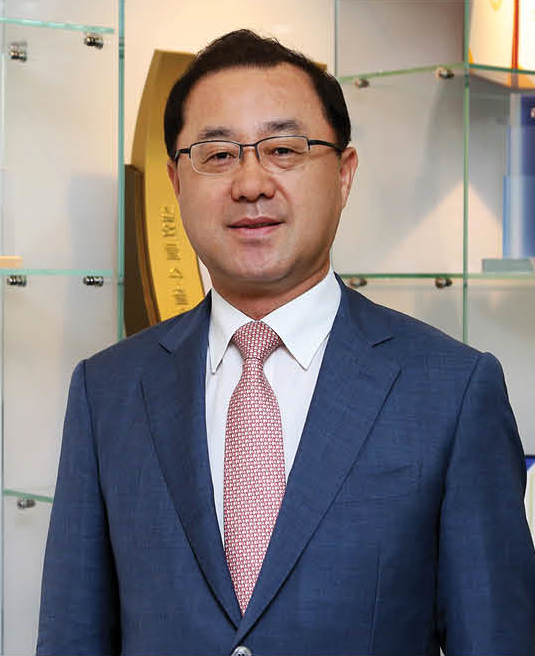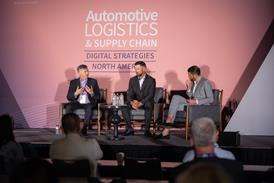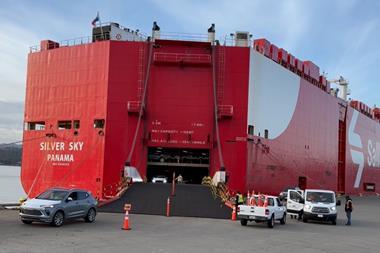 A mix of carrier, 3PL, 4PL integrator and central logistics purchaser, Hyundai Glovis’s strength and expansion rely on third parties as well as Hyundai-Kia
A mix of carrier, 3PL, 4PL integrator and central logistics purchaser, Hyundai Glovis’s strength and expansion rely on third parties as well as Hyundai-Kia
The rise of Hyundai Glovis has been the logistics parallel to Hyundai and Kia’s emergence as production and export superpowers. The company has solidified its position as a supply chain integrator across the Hyundai Motor Group, making use of its increasing purchasing power in negotiating logistics services, investing in direct shipping, port and trucking equipment, and a set of IT systems designed specifically for Hyundai-Kia.
In this story...
As part of the Hyundai Motor Group, Glovis moves to the beat of the carmakers’ drum. Last year, it incorporated a Mexico subsidiary to handle Hyundai Motor sales in the country, with an eye on the 2016 launch of Kia’s plant in Monterrey. Glovis also has fleets of bulk and pure-car-and-truck carriers (PCTCs), which last year carried 891,000 Hyundai vehicles and 420,000 Kia exports out of Korea, India, Turkey, the Czech Republic and Slovakia. Hyundai Glovis plans to expand its ro-ro fleet from around 60 vessels today to 100 by the end of the decade, according to Sang Sok Suh, director of the planning and strategy group at Hyundai Glovis.
Such expansion is not calculated solely on Hyundai and Kia’s growth, especially as the OEMs’ regional production capacities are growing faster than their exports from South Korea. Rather, a significant share of Glovis’s PCTC volume will be for third party customers, which today make up nearly 45% of the cargo mix.
Glovis’s total revenue outside affiliated Hyundai Motor companies is now around 27%. “This has grown a lot in the past five years, and our goal is for 50% 3PL volume by 2020,” says Suh, who is based at Glovis’s Seoul headquarters. “The shipping business will be important to reaching this target.”
According to executives at the company’s Glovis America subsidiary, it is even considering entering the short-sea market for North America, mainly for exports out of Mexico.

Glovis is also expanding its shipping focus by building its first port terminal; the company will invest 72 billion won ($65m) at Pyeongtaek-Dangjin, a major port for finished vehicles located 70km south of Seoul. Glovis expects to eventually handle up to 400,000 vehicles here after operations begin in 2017. That volume will likely include Hyundai and Kia vehicles – both of which currently use existing terminals at the port – as well as high-and-heavy cargo and equipment from other sectors.
Glovis’s foreign subsidiaries are also encouraged to explore opportunities beyond the group. A recent example was Glovis taking a controlling stake in Poland’s Adampol, which gives it a strategic fleet for Hyundai and Kia, while also connecting it to a portfolio of car brands across Europe and Russia.
“Hyundai Glovis’s strategy is that ‘localisation is the motor of growth’,” says Suh. “We have more than 30 branches, and they are each chasing business one after the other. Their primary job is to focus on Hyundai-Kia, but they are also very hungry for third party business.”
Being within the Hyundai Motor Group, while pursuing growth beyond it, is a defining feature of Hyundai Glovis. The company is commonly referred to as Hyundai Motor’s logistics ‘subsidiary’ or ‘division’, however its roles as a group provider and third party company – both for Hyundai and its sister companies – make it a more complicated case study in South Korean automotive logistics. The company moves between being a carrier, a 3PL, a 4PL integrator, and a central logistics purchasing team for Hyundai and Kia.
It would be wrong to define Hyundai Glovis too narrowly within any of these categories, as its revenue (close to $13 billion in 2014) is a hybrid of commercial business and Hyundai-Kia’s huge logistics demand. It’s not uncommon for some providers in South Korea, as well as some shipping lines, to view Glovis as a potential customer as well as a competitor.
This complexity is a by-product of sprawling chaebol industrial organisations. For Hyundai Motor Group, there are 60 or so automotive companies wrapped together by cross-ownership and shareholdings that operate with varying degrees of independence and decentralisation. (Other ‘Hyundai’ brands, in sectors like shipping, heavy industry and retail, were disentangled from Hyundai Motor after the Asian financial crisis.)
Under the broad leadership of chairman Chung Mong-koo, many group strategies move in similar directions. Hyundai and Kia share research and development, for example, and tend to mirror one another globally: a freeze in production capacity expansion was applied across both brands in recent years, and subsequently lifted for both. They also often enter new markets in proximity to one another. However, design, marketing and sales are distinctly separate, with the brands competing against each other.
 For logistics and supply chain management, there isn’t a central department connecting Hyundai and Kia, and such functions vary between markets even within the brands.
For logistics and supply chain management, there isn’t a central department connecting Hyundai and Kia, and such functions vary between markets even within the brands.
In Korea, both have separate export administration teams; in Europe, meanwhile, Kia’s corporate entity has a supply chain management department that doesn’t have a direct parallel at Hyundai Europe or Kia’s global headquarters.
Hyundai Glovis is similarly conjoined yet separate. It is responsible for its own strategy and business plan, profits and investments, and has been listed on the stock market since 2005. On the other hand, the company is embedded in the group, and will soon share the same consolidated headquarters at a new skyscraper in central Seoul. Many Hyundai Glovis executives, including its current CEO, have previously worked at the carmaker. Before moving over to Glovis in 2008, Sang Sok Suh also worked at Hyundai Motor in sales, procurement and the strategy and coordination group in a similar role to that which he has now at Glovis.
Glovis has an independent shareholding structure, which includes a significant share owned by the Hyundai Motor chairman and his family. The majority of shares are owned by independent investors and companies, including a portion by Norwegian shipping group Wilh. Wilhelmsen Group.
As a group provider, Glovis carries out most of Hyundai and Kia’s inbound, warehouse, plant and vehicle logistics. It also has business with other subsidiary companies, including Hyundai Steel and Mobis. An essential reason behind the company’s creation in 2001 was to combine and share the resources of Hyundai, Kia and others in the supply chain.
“We are able to achieve economies of scale in logistics. We can see this especially in shipping, where we put together containers for Hyundai, Kia, Mobis and Hyundai Steel, and then negotiate with shipping companies and port operators,” says Suh.
Glovis’s move towards consolidation across Hyundai and Kia has also been strong globally across outbound logistics, where it has consistently combined vehicles at ports of import or output from plants across Europe and North America.
In operational terms, however, Suh makes it clear who calls the shots. “Glovis is the centre for best practices in logistics across the group. However, we are subcontractors to Hyundai Motor,” he says. “We follow contracts by the rules it suggests.”
Key forecasts, production planning and launch schedules are shared each month and refined during weekly meetings and regular exchanges with Glovis, but the data is linked across separate IT systems between Hyundai, Kia and Glovis. While Glovis uses its own transport management system, Hyundai and Kia each have distribution systems to control export flows, according to Jwa Daesung, team leader and general manager of Hyundai Motor Company’s export administration department. “When more information is needed, Hyundai Motor asks Hyundai Glovis for additional information,” Jwa says.
 In South Korea, Hyundai Glovis not only subcontracts a variety of logistics services for Hyundai and Kia, but it also has a significant fleet of trucks and carries out a large amount of transport services itself
In South Korea, Hyundai Glovis not only subcontracts a variety of logistics services for Hyundai and Kia, but it also has a significant fleet of trucks and carries out a large amount of transport services itselfHyundai and Kia rarely share strategic information related to future plans, supplier sourcing, plant locations or other sensitive data, according to Suh. “They hold such information close to their chest, including from Glovis. Our job is to meet the right quality and cost levels for each service,” he says.
When it comes to Hyundai-Kia’s supply chain, Glovis controls certain logistics decisions, while elsewhere it executes Hyundai Motor orders, or works in combination with it. According to Jwa Daesung, Hyundai Motor is responsible for vehicles from production through ocean shipping. “Hyundai Glovis takes over operations after shipping to delivery,” he says. “Schedules regarding shipping are jointly negotiated and managed by Hyundai Motor and Hyundai Glovis.”
For the transport of vehicles, Jwa adds that Hyundai Glovis sets the fleet schedule based on Hyundai Motor’s production plan. “Then, Hyundai Glovis carries out the fleet schedule after discussing it with Hyundai Motor,” he says.
Within this structure, Glovis has a variety of roles in the outbound supply chain from Korea. It hauls cars from plants to ports usually on its own truck fleet; in other cases, it arranges rail services or holding yards. Some parts of the chain, however, are directly managed by Hyundai and Kia or subcontracted to other providers. At Pyeongtaek port, Glovis delivers Kia vehicles to the carmaker’s own terminal, where logistics provider CJ Korea Express handles vehicle inspection and yard management on behalf of Kia. Later, CJ Korea drivers move vehicles onto Eukor or Glovis vessels. For Hyundai brand vehicles, Glovis moves the cars to a different terminal owned by WWL and Eukor.
 Inventory management also varies. A spokesperson for Kia’s logistics management reveals that, following growth in exports in 2014, the carmaker needed to secure temporary holding yards for vehicles. For domestic-bound vehicles, Kia’s distribution team managed the yards directly, while Glovis procured the facilities for export vehicles.
Inventory management also varies. A spokesperson for Kia’s logistics management reveals that, following growth in exports in 2014, the carmaker needed to secure temporary holding yards for vehicles. For domestic-bound vehicles, Kia’s distribution team managed the yards directly, while Glovis procured the facilities for export vehicles.
The picture is different across global markets. In some subsidiaries, such as the US and central Europe, Glovis is usually a shipper for Hyundai-Kia, combining Hyundai and Kia volume together out of plants or ports and procuring transport services across modes rather than doing the transport itself.
Elsewhere, national sales companies have kept logistics responsibility with local distribution teams. In China, Glovis is not performing all the services for Hyundai and Kia joint ventures that it does in other markets, such as complete knockdown kit imports or vehicle delivery from plants. Suh says that Glovis is investing in its China operations to work more closely with both Hyundai-Kia and third parties.
Opportunity ahead
That there are operational areas within Hyundai-Kia where Glovis can still gain business and influence demonstrates potential within the group itself. “We still have capacity to give best practices to Hyundai and Kia and expand in our major markets like North America and Europe,” Suh says. “With the new plants in China and Mexico, we also have the opportunity to get more business.”
Such potential exists close to home as well. With the terminal investment at Pyeongtaek, Glovis hopes to gain more business from both Hyundai and Kia, as both carmakers face space constraints in their current facilities. The Pyeongtaek terminal is also a chance for Glovis to combine 3PL business with Hyundai-Kia services and make better use of its trucking, PDI and shipping assets by bringing together other customers and industries.
Suh sees improving scale and asset utilisation as a critical step in Glovis’s development and the management of Hyundai-Kia’s supply chain, especially as growth slows. Both companies, he says, are demanding higher quality at lower costs. “This is a real struggle for us,” he admits. “But we need to satisfy them, and that could mean greater cooperation and packaging of services in the supply chain. By serving other customers, we can better use our assets.”
 Hyundai Motor’s Jwa Daesung says that the carmaker is not opposed to Glovis pursuing third party business, as long as it has no impact on its own vehicle movements
Hyundai Motor’s Jwa Daesung says that the carmaker is not opposed to Glovis pursuing third party business, as long as it has no impact on its own vehicle movementsBroadly, Hyundai and Kia executives are open to Glovis working with other customers, so long as it improves overall efficiency and poses no threat to their own service.“We do not see any conflicts with Hyundai Glovis increasing third party business and we believe this is a part of the company’s own business,” says Hyundai Motor’s Jwa Daesung. “Hyundai Motor is the most important shipper for Hyundai Glovis and it puts utmost priority on shipping our vehicles.”
Hyundai Glovis does seem to have set its targets more clearly on business that does not conflict with Hyundai or Kia in anyway. For example, the new Glovis terminal in Pyeongtaek will obviously seek to serve Hyundai and Kia, while incorporating some third party business – in particular, non-competing industries such as high-and-heavy, and commercial equipment. “It could be that we handle Hyundai and Kia for vehicles, but also finished goods for companies like Hyundai Heavy Industries, such as cranes that could also be loaded onto our vessels,” says Suh. (Hyundai Heavy Industries has no financial links to Hyundai Motor Group.)
Looking ahead, Sang Sok Suh envisions Hyundai Glovis as even more global and interconnected across the supply chain, including combining Hyundai and Kia flows more effectively. Improved IT services could better collect data across production, distribution and sales stages, and feed them through to logistics services, he says.
Technology should also allow integrated management and services, whether vehicles originate in Turkey or South Korea, or an executive is seated in Seoul or Dubai. Suh believes tomorrow’s Hyundai Glovis leaders must learn to be nearly everywhere at all times.
“Our future management system will be more global,” he says. “A vice-president or higher may have to work one month in China, one in Europe, in India and then in North America, before coming back to Seoul and starting the cycle over again.”
Hyundai Glovis is not the only OEM-owned logistics company pursuing business opportunities outside its group, although the scale of the company, which could approach $14 billion in revenue this year, and its global presence, dwarf most examples.
In Japan, carmakers like Toyota, Nissan and Honda have historically owned some transport companies and assets, from vehicle shipping to warehousing, some of which they have extended to other markets. These operations typically remain focused on niche segments or specific areas, such as Toyota’s shipping joint venture, Toyofuji; its car haulier fleet on the US west coast; or Honda’s warehouse and material handling provider, Midwest Express. In-house trading companies, such as Toyota Tsusho or Honda Trading, have also taken on some global supply chain and freight forwarding roles, although these tend to cover specific intra-company flows or markets.
American carmakers too have had various interests in transport assets over the decades, including trucking fleets at Chrysler. In the early 2000s, several US manufacturers tried to turn their in-house logistics or IT management into joint ventures intended to manage entire networks and potential third parties, such as GM’s Vector, or the online platform Covisint, originally between GM, Ford and DaimlerChrysler. However, OEMs later brought most of these ventures back in-house or withdrew their participation.
In China, state-owned carmakers like SAIC and FAW have logistics subsidiaries (such as Anji Automotive and FAW Logistics) that run transport for their own plants and western joint ventures, as well as for other, non-affiliated carmakers in China. However, central planning rules on joint ventures distort the market from what it might look like if foreign brands had more influence over logistics. Up to now at least, such logistics companies have had little impact outside China.
Europe has shown an interesting evolution, with several manufacturers having owned logistics companies, such as PSA Peugeot Citroën’s Gefco, Renault’s Groupe CAT, Volvo Logistics from truckmaker AB Volvo and, to some extent, Volkswagen Group’s Volkswagen Logistics. Such providers benefitted from their close links to manufacturers’ supply chains, but were also run at arm’s length so that they might pursue other business. However, some outside customers worried that these providers would prioritise their owners at critical times.
In some ways this tension was only overcome when OEMs spun these logistics companies off, or focused them solely on internal group business. Gefco and CAT were partly or wholly sold off, and have an increasingly broad range of customers. A somewhat different path can be observed for the rebranded Volvo Group Logistics Services, as well as for what is now called Volkswagen Group Logistics, which act more like central logistics functions and now work almost entirely within their respective groups.
Predicting whether Hyundai Glovis’s place within Hyundai Motor might eventually change is difficult. Spinning it off from Hyundai is not necessary, points out Sang Sok Suh, because it is already a separate, stock-listed company. Moving deeper into group management functions seems possible in some regions, but not necessarily within the company’s long-term strategy, especially with the push to acquire more third party business.
The South Korean government has accelerated chaebol reforms, which partly spurred changes even within Glovis’s own shareholding structure this year. However, these changes have had little to no impact on operations, while few analysts are currently predicting radical changes in the wider group, or in Hyundai Glovis’s position as Hyundai Motor Group’s core provider.
Click here to read part 5 in our South Korea series, "Pyeongtaek-Dangjin: Complexity made simple". (Published July 15th)
Click here to read the full list of stories in this special section.



































